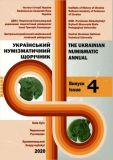МАЛОВІДОМИЙ ТИП НАСЛІДУВАННЯ ДИРХЕМА З «КНЯЗІВСЬКИМ ЗНАКОМ» ВОЛОДИМИРА ОЛЬГЕРДОВИЧА
THE UNKNOWN TYPE OF DIRHEM IMITATION WITH THE “KNIGHTS ‘SIGN” OF VOLODYMYR OLGERDOVYCH
Author(s): Oleksandr Potyl’chakSubject(s): Archaeology, 13th to 14th Centuries
Published by: ДВНЗ Переяслав-Хмельницький державний педагогічний університет імені Григорія Сковороди
Keywords: Kyiv apanage principality; Volodymyr Olgerdovych; Toktamysh; dirhem; imitation; “princely sign”;
Summary/Abstract: The purpose of the article is to introduce into the scientific circulation, attribution and research until recently unknown to the numismatists, a rare and little-studied type of local imitation of Khan Toktamysh dirhems (1380–1399) of the minting of Prince Volodymyr Olgerdovych of Kyiv (1362–1394). The author examines the circumstances and geography of coin detection, analyses the results of metrological research of findings, raises questions about the eminent, the causes of this type of imitation, the period of minting, the specifics of circulation, and offers own version of the attribution of the “princely sign” on the obverse of the coins. The research methodology is outlined by the principles of scientific, historicism, objectivity, methods of analysis, classification, generalisation, historical-genetic and historical-typological, method of stamp analysis. Scientific novelty. A probable prototype for imitation could be the dirhem of Khan Toktamysh of the mint of Saray al-Jadid with the date 794. At present, four coins of this type engraved by one stamp for an obverse and two different stamps for reverse known from the numismatic literature. The main argument that allows us to link the investigated coinage with Volodymyr Olgerdovych is the stylistic identity of the “princely sign” on the obverse of imitation with the heraldic element known to the numismatists of the denariuses of that particular prince. The date (794 AD), which is present on the coin, as well as the historical circumstances of the displacement of Volodymyr from the Kyiv table by Grand Duke of Lithuania Vytautas Keistutovich, make it possible to outline the period of minting of this type of coins 1392–1394. Comparison of metrological indicators of the studied coins, synchronous in time of regular coinage dirhems and previously known types of imitation, shows that dirhems with the “princely sign” occupy an intermediate place in this series, inferior to the weight and diameter of the Horde emissions, but far outweighed by these indicators, the known denariuses of Volodymyr Olgerdovych. The results of X-ray fluorescence analysis of the coin alloy showed a very high silver content and low impurities of gold and copper. The oval shape of the coins indicates the use of “wire” coinage techniques and the relative accuracy of the reproduction of the Arabic text on the coin stamps proves their production by a professional, which is either understood in the Kufic font, or has seen a coin prototype. Mapping of places of detection of coins’ imitations with the “princely sign” of Volodymyr Olgerdovych (along the broad line of the Lithuanian-Tatar border within the southern, eastern terrains of the Kyiv apanage principality and the neighbouring southern lands of the Principality of Siver). The numismatic sources introduced into the scientific circulation and the updated source information allow us to assume that economic motives were the primary purpose of the studied coinage. Namely, it was the filling of the local money market within the Kyiv principality by the coin mass. Existing numismatic sources do not sufficiently confirm the involvement of this mint in trading or paying tribute to the Horde. However, it does not deny the possibility of the sporadic penetration of Kyiv dirhem imitation with the “princely sign” into the vast expanses of the Lithuanian-Horde border, mainly through retail trade and money transactions. We suppose that one of the reasons for the coinage of this type of imitation by Volodymyr Olgerdovych could have been provoked by the complex military-political realities in the region, the prince’s desire for broader political autonomy and revisiting in the future his status as a tribute and vassal in relations with the Horde and the Grand Duchy of Lithuania. The author’s observations suggest stylistic connection of the “princely sign” of our coin with the generic emblems of the Kyiv princes of the X-XI centuries. The precise spatial orientation of this heraldic element on the coins studied makes it possible to raise the issue of revising the idea of the spatial orientation of the “princely sign” on the Kyiv denariuses of Volodymyr Olgerdovych. The Conclusions. A preliminary study and attribution of a numismatic monument discovered gives grounds to claim that we are dealing with a new, little-known and currently unknown type of imitation of the coins of Khan Toktamysh by PrinceVolodymyr Olgerdovych of Kyiv (1362–1394). The presence on the attributed coin a heraldic element in the form of a “princely sign” may indicate to the formalised coinage and its affiliation with the regular regional imitation of Juchid coins.
Journal: Український Нумізматичний Щорічник
- Issue Year: 2020
- Issue No: 4
- Page Range: 89-103
- Page Count: 15
- Language: Ukrainian

